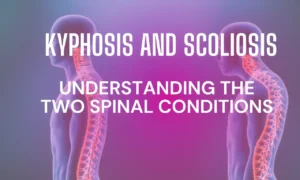Kyphosis and Scoliosis: Understanding the Two Spinal Conditions

According to research, 2-3% of the US population is affected by scoliosis yearly, while kyphosis affects 0.4 % of the US population. Both are two spinal conditions that can cause physical discomfort. Furthermore, both diseases can also impair a person's quality of life. In this blog, we will discuss in detail these two diseases, including their types and treatment options.
Kyphosis
Kyphosis is when a patient experiences an excessive curvature of the thoracic spine. Moreover, it results in a forward rounding of the upper back. Various causes behind this spinal disease include poor posture, degenerative diseases, developmental abnormalities, and certain traumas. Hence, it can lead to stiffness, pain, and breathing difficulties.
Types of Kyphosis
Although kyphosis has many types, the most common ones are postural kyphosis, Scheuermann's kyphosis, congenital kyphosis, and neuromuscular kyphosis. Below is the description of these four types.
1. Postural Kyphosis
This type of kyphosis is caused by poor posture, which you can correct through exercise and posture improvement. Consulting with an expert neurologist will help a lot.
2. Scheuermann’s Kyphosis
This kyphosis type usually occurs during adolescence and is caused by the development of wedge-shaped vertebrae. As a treatment, surgeons suggest a back brace, physical therapy, or surgery.
3. Congenital Kyphosis
Kyphosis this type is caused by a congenital disability in which the spine of the person doesn't form properly. Spinal fusion surgery can help relieve this pain.
4. Neuromuscular Kyphosis
This kyphosis occurs when a specific condition affects nerves and muscles, such as palsy, muscular dystrophy, and spinal bifid. The best treatment options for this disorder are physiotherapy and manual exercise.
Treatment Options
Treatment of kyphosis depends on its severity and underlying cause. As kyphosis has many types, the treatment will differ for every type. In mild cases, exercise and posture improvement can help. While in severe cases, surgery is the only option left.
Scoliosis
Scoliosis is another spinal condition that is characterized by an abnormal curvature of the spine. This curvature usually happens in an "S" or "C" shape. Various factors can cause this spinal disorder, including developmental abnormalities, trauma, and degenerative diseases. Just like kyphosis, it also leads to pain, stiffness, and breathing difficulties.
Types of Scoliosis
Scoliosis has various types but the most common ones are idiopathic scoliosis, congenital scoliosis, neuromuscular scoliosis, and degenerative scoliosis. Read more about these types below.
1. Idiopathic Scoliosis
It is the most common type of scoliosis; its exact cause is still unknown. The abnormal curve developed in this disorder can be treated by spinal fusion.
2. Congenital Scoliosis
Some congenital disability causes this type of scoliosis. As a result, the spine doesn't form properly. Surgery is the most appropriate treatment for this type.
3. Neuromuscular Scoliosis
A specific condition that affects nerves and muscles causes this scoliosis type. It includes cerebral palsy, spinal bifida, and muscular dystrophy. Spinal fusion can be an effective treatment for this.
4. Degenerative Scoliosis
Degenerative changes in the spine, usually related to aging, cause degenerative scoliosis. Physical therapy, exercise, and pain management are the few treatments doctor recommend for this type.
Treatment Options
Like kyphosis, scoliosis's treatment depends on its severity and underlying cause. Mild cases can be treated by exercise and braces. For severe cases, surgery or spinal fusion is the best option. Above all, some scoliosis cases may not require any treatment at all.
FAQs
1. At what point does scoliosis become a disability?
The severity of the curvature affects each patient's ability to perform daily activities differently. If the curvature significantly impacts the patient's mobility, it can become a disability. Consultation with a medical professional is recommended in this scenario.
2. How do you fix scoliosis and kyphosis?
Treatment for both scoliosis and kyphosis depends on the patient's condition and the severity of the curvature. In some cases, physical therapy and exercise are enough; in severe cases, the patient may need spinal fusion or surgery. It's better to consult with an expert neurosurgeon for the best course of treatment.
3. What happens if kyphosis is left untreated?
Left untreated, kyphosis can lead to pain, difficulty breathing, and stiffness. It also enhances potential complications and deformities with the spinal cord and nerves.
4. Which is worse, kyphosis or scoliosis?
Both kyphosis and scoliosis can affect your lifestyle as these two are spinal deformities. According to doctors, kyphosis is more painful than scoliosis. Overall, the impact of each condition depends on the degree of curvature. A neurosurgeon will assess better about severity and treatment of scoliosis and kyphosis.


Dr. Baker specializes in neurosurgery, neurosurgical spine surgery, neurotrauma, brain tumors, spinal tumors, and peripheral nerve damage treatment.